Lancia Delta 2011 Owner handbook (in English)
Manufacturer: LANCIA, Model Year: 2011, Model line: Delta, Model: Lancia Delta 2011Pages: 290, PDF Size: 8.36 MB
Page 141 of 290

140KNOWING YOUR CAR
FRONT AND REAR PARKING SENSORS
(combined with Magic Parking)
(for versions/markets where provided)
The parking sensors provide the driver with distance in-
formation when approaching obstacles in front of and be-
hind the vehicle (versions with 4 front and 4 rear sensors)
always combined with the Magic Parking function. The
system therefore provides a further aid during parking
manoeuvres because it allows the identification of obsta-
cles outside of the driver’s field of vision. The driver is notified of the presence and distance of the
obstacle from the vehicle by an acoustic signal which
varies depending on the distance from the obstacle (as the
distance from the obstacle decreases the frequency of the
acoustic signal increases).
SENSORS
In order to measure the distance of obstacles, the system
uses 4 sensors located in the front bumper (where pro-
vided) fig. 85 and 4 sensors located in the rear bumper
fig. 86.
fig. 85L0E0059mfig. 86L0E0250m
Page 142 of 290

1
KNOWING YOUR CAR141
Version with 8 sensors
On the version with 4 front sensors and 4 rear sensors,
the system is activated when reverse gear is engaged or
by pressing the button fig. 87. If there has been a request
to activate the Magic Parking function, the front and rear
sensors are not automatically activated during the search
for a parking space, but can be activated by pressing the
special button (fig. 87) or by engaging reverse gear when
the speed is below around 15 km/h.
When reverse gear is released, the front and rear sensors
remain activated until a speed of around 15 km/h is ex-
ceeded to allow the parking manoeuvre to be completed.
The system can also be activated by pressing the button
fig. 87 in the central panel: a warning light in the but-
ton comes on when the system is activated.The sensors are deactivated by pressing the button again
fig. 87 or when a speed of 15 km/h is exceeded: the
warning light in the button is off when the system is not
active.
When the sensors are activated, the system starts to pro-
duce acoustic signals from the front or rear buzzers as
soon as an obstacle is detected with the frequency in-
creasing as the obstacle gets closer.
When the obstacle is less than about 30 cm away, the
sound becomes continuous. Depending on the position of
the obstacle (in front or behind) the sound is produced
by the corresponding buzzers (front or rear). The obsta-
cle closest to the vehicle is signalled.
The acoustic signal stops immediately if the distance of
the obstacle increases. The sound cycle remains constant
if the distance measured by the centre sensors remains
unchanged, whilst if this situation occurs for the side sen-
sors, the signal is interrupted after about 3 seconds (for
example, to prevent signals in the case of manoeuvres
alongside walls).
fig. 87L0E0249m
The responsibility for parking and other
dangerous manoeuvres always and in every
case lies with the driver. While manoeu-
vring, always make sure that no-one is in the area
concerned (especially children) or animals. The
parking sensors are designed to assist drivers: in
any case, you must always pay the utmost atten-
tion during potentially dangerous manoeuvres,
even when carried out at low speed.
Page 143 of 290

142KNOWING YOUR CAR
ACOUSTIC SIGNAL
The information concerning the presence and distance of
an obstacle from the vehicle is transmitted by means of
acoustic signals from 2 buzzers installed in the passenger
compartment:
❍a front buzzer warns of the presence of obstacles at
the front and a buzzer located at the rear warns of the
presence of obstacles at the rear. This notifies the driver
of the direction (front/rear) of the obstacles.
Operation is automatically activated when reverse gear
is engaged.
The acoustic signal:
❍increases as the distance between the car and the ob-
stacle decreases;
❍becomes continuous when the distance between the
car and the obstacle is less than around 30 cm and stops
immediately if the distance increases;
❍is constant if the distance is unvaried; if this situa-
tion occurs for the side sensors, the indication will stop
after about 3 seconds to avoid, for example, warning in-
dications in the event of manoeuvres alongside walls.The sensor must be clean of mud, dirt, snow
or ice in order for the system to operate cor-
rectly. Be careful not to scratch or damage the
sensors while cleaning them. Avoid using dry, rough
or hard cloths. The sensors should be washed using
clean water with the addition of car shampoo if nec-
essary. When using special washing equipment such
as high pressure jets or steam cleaning, clean the
sensors very quickly keeping the jet more than
10 cm away.
Only have the bumpers repainted or any re-
touches to the paintwork in the area of the
sensors carried out by a Lancia Dealership.
If the paint is incorrectly applied this could ad-
versely affect the operation of the parking sensors.
SENSOR OPERATING RANGE
The sensors allow the system to check the front part (ver-
sion with 8 sensors) and rear part of the vehicle.
Their position covers the middle and side areas of the
front and rear of the vehicle.
If an obstacle is located in a middle area, it is detected
when the distance is less than about 0.9 m (front) and
1.30 m (rear).
Page 144 of 290
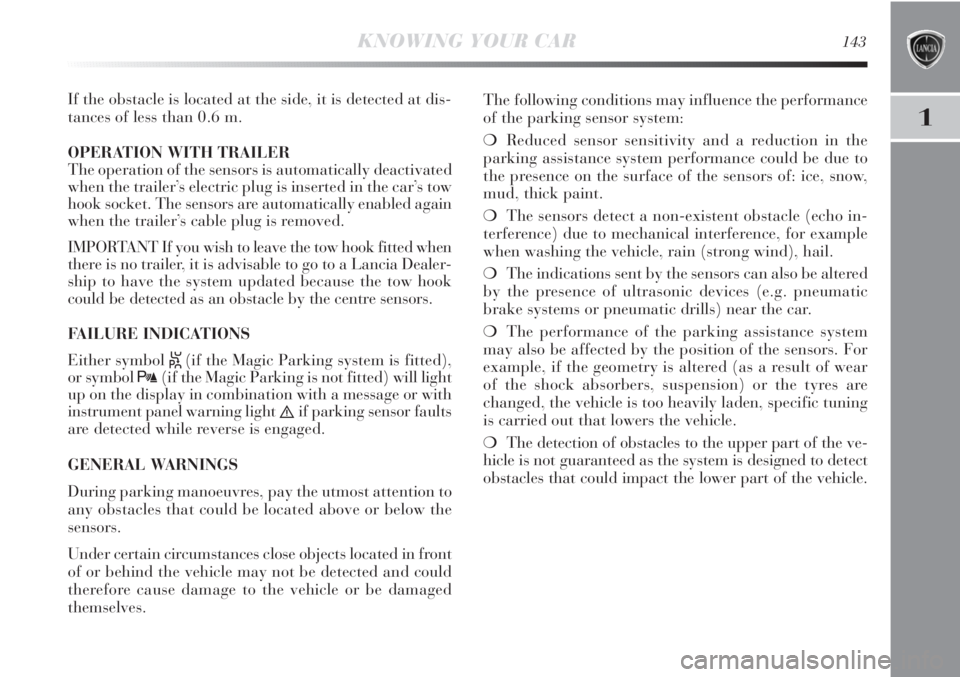
1
KNOWING YOUR CAR143
If the obstacle is located at the side, it is detected at dis-
tances of less than 0.6 m.
OPERATION WITH TRAILER
The operation of the sensors is automatically deactivated
when the trailer’s electric plug is inserted in the car’s tow
hook socket. The sensors are automatically enabled again
when the trailer’s cable plug is removed.
IMPORTANT If you wish to leave the tow hook fitted when
there is no trailer, it is advisable to go to a Lancia Dealer-
ship to have the system updated because the tow hook
could be detected as an obstacle by the centre sensors.
FAILURE INDICATIONS
Either symbol
S(if the Magic Parking system is fitted),
or symbol
t(if the Magic Parking is not fitted) will light
up on the display in combination with a message or with
instrument panel warning light
èif parking sensor faults
are detected while reverse is engaged.
GENERAL WARNINGS
During parking manoeuvres, pay the utmost attention to
any obstacles that could be located above or below the
sensors.
Under certain circumstances close objects located in front
of or behind the vehicle may not be detected and could
therefore cause damage to the vehicle or be damaged
themselves.The following conditions may influence the performance
of the parking sensor system:
❍Reduced sensor sensitivity and a reduction in the
parking assistance system performance could be due to
the presence on the surface of the sensors of: ice, snow,
mud, thick paint.
❍The sensors detect a non-existent obstacle (echo in-
terference) due to mechanical interference, for example
when washing the vehicle, rain (strong wind), hail.
❍The indications sent by the sensors can also be altered
by the presence of ultrasonic devices (e.g. pneumatic
brake systems or pneumatic drills) near the car.
❍The performance of the parking assistance system
may also be affected by the position of the sensors. For
example, if the geometry is altered (as a result of wear
of the shock absorbers, suspension) or the tyres are
changed, the vehicle is too heavily laden, specific tuning
is carried out that lowers the vehicle.
❍The detection of obstacles to the upper part of the ve-
hicle is not guaranteed as the system is designed to detect
obstacles that could impact the lower part of the vehicle.
Page 145 of 290

144KNOWING YOUR CAR
ACCESSORIES PURCHASED
BY THE OWNER
If you decide to install electrical accessories after the car
has been purchased which require a permanent electric
power supply (alarm, anti-theft, satellite based etc.) or
accessories which have a serious impact on the electrical
balance, seek assistance from a Lancia Dealership be-
cause their qualified staff will suggest the most suitable
Lancia Lineaccessori devices and assess the overall elec-
tric consumption, checking whether the car’s electrical
system can cope or whether a more powerful battery is
required.ELECTRICAL/ELECTRONIC DEVICE
INSTALLATION
The electric/electronic devices installed subsequent to the
purchase of the car and included in the after-sales service
must be marked:
Fiat Group Automobiles S.p.A. authorises the installation
of transceiver devices on condition that such installations
are carried out in a workmanlike fashion, following the
manufacturer’s instructions, at a specialised centre.
IMPORTANT Traffic authorities may not allow the ve-
hicle on the road if devices are fitted that modify vehicle
specifications. This may also invalidate the warranty in
relation to faults caused by the change or either directly
or indirectly related to it. Fiat Group Automobiles S.p.A.
shall not be liable for damage caused by the installation
of accessories either not supplied or recommended by Fiat
Group Automobiles S.p.A. and/or not installed in com-
pliance with the provided instructions.
Page 146 of 290
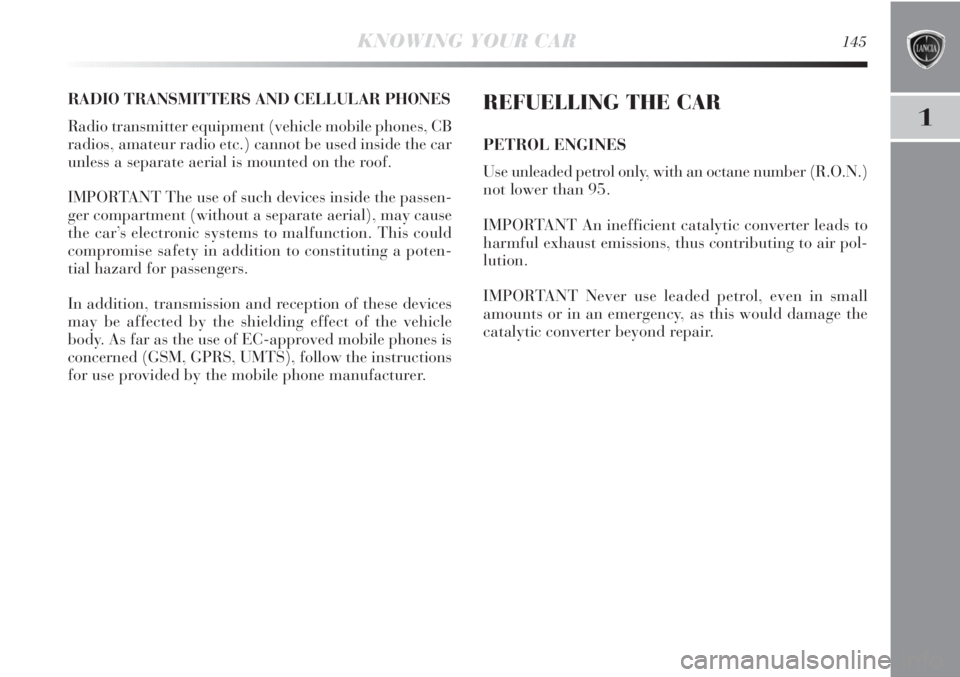
1
KNOWING YOUR CAR145
RADIO TRANSMITTERS AND CELLULAR PHONES
Radio transmitter equipment (vehicle mobile phones, CB
radios, amateur radio etc.) cannot be used inside the car
unless a separate aerial is mounted on the roof.
IMPORTANT The use of such devices inside the passen-
ger compartment (without a separate aerial), may cause
the car’s electronic systems to malfunction. This could
compromise safety in addition to constituting a poten-
tial hazard for passengers.
In addition, transmission and reception of these devices
may be affected by the shielding effect of the vehicle
body. As far as the use of EC-approved mobile phones is
concerned (GSM, GPRS, UMTS), follow the instructions
for use provided by the mobile phone manufacturer.REFUELLING THE CAR
PETROL ENGINES
Use unleaded petrol only, with an octane number (R.O.N.)
not lower than 95.
IMPORTANT An inefficient catalytic converter leads to
harmful exhaust emissions, thus contributing to air pol-
lution.
IMPORTANT Never use leaded petrol, even in small
amounts or in an emergency, as this would damage the
catalytic converter beyond repair.
Page 147 of 290
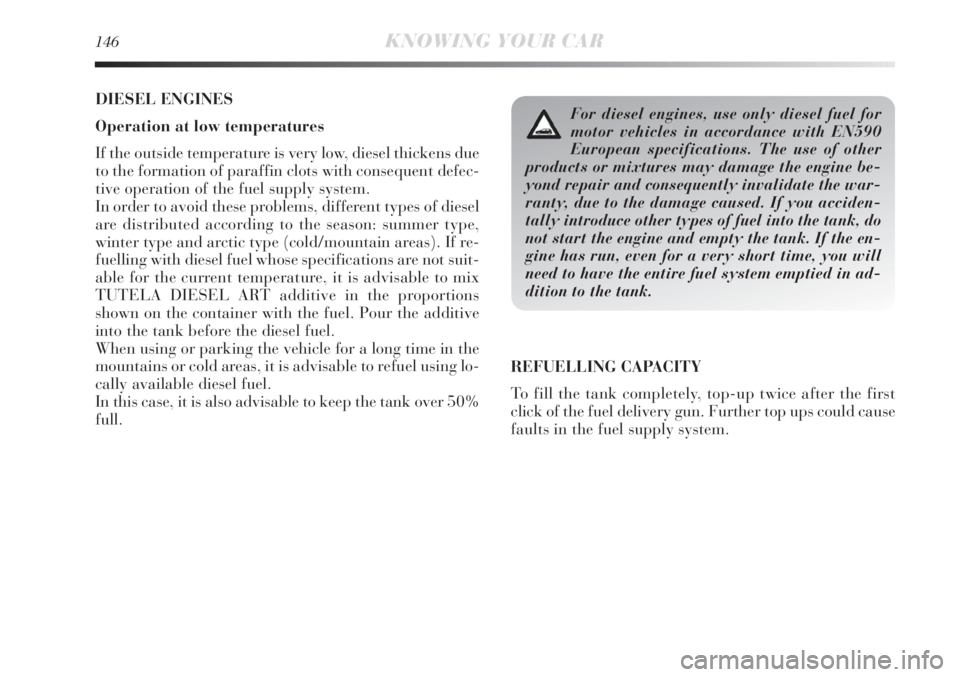
146KNOWING YOUR CAR
DIESEL ENGINES
Operation at low temperatures
If the outside temperature is very low, diesel thickens due
to the formation of paraffin clots with consequent defec-
tive operation of the fuel supply system.
In order to avoid these problems, different types of diesel
are distributed according to the season: summer type,
winter type and arctic type (cold/mountain areas). If re-
fuelling with diesel fuel whose specifications are not suit-
able for the current temperature, it is advisable to mix
TUTELA DIESEL ART additive in the proportions
shown on the container with the fuel. Pour the additive
into the tank before the diesel fuel.
When using or parking the vehicle for a long time in the
mountains or cold areas, it is advisable to refuel using lo-
cally available diesel fuel.
In this case, it is also advisable to keep the tank over 50%
full.For diesel engines, use only diesel fuel for
motor vehicles in accordance with EN590
European specifications. The use of other
products or mixtures may damage the engine be-
yond repair and consequently invalidate the war-
ranty, due to the damage caused. If you acciden-
tally introduce other types of fuel into the tank, do
not start the engine and empty the tank. If the en-
gine has run, even for a very short time, you will
need to have the entire fuel system emptied in ad-
dition to the tank.
REFUELLING CAPACITY
To fill the tank completely, top-up twice after the first
click of the fuel delivery gun. Further top ups could cause
faults in the fuel supply system.
Page 148 of 290
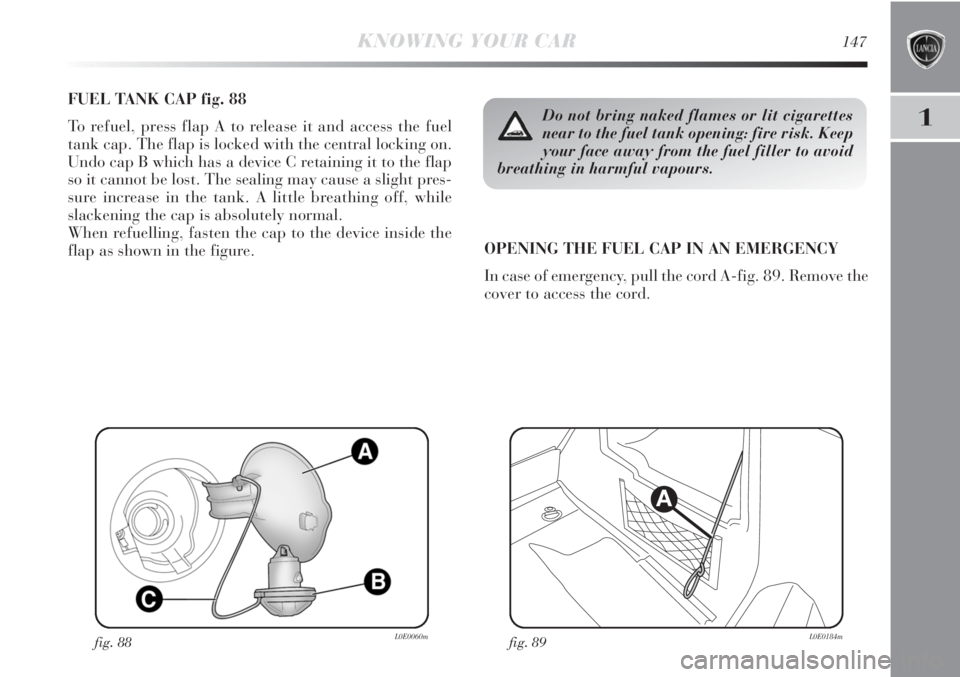
1
KNOWING YOUR CAR147
FUEL TANK CAP fig. 88
To refuel, press flap A to release it and access the fuel
tank cap. The flap is locked with the central locking on.
Undo cap B which has a device C retaining it to the flap
so it cannot be lost. The sealing may cause a slight pres-
sure increase in the tank. A little breathing off, while
slackening the cap is absolutely normal.
When refuelling, fasten the cap to the device inside the
flap as shown in the figure.OPENING THE FUEL CAP IN AN EMERGENCY
In case of emergency, pull the cord A-fig. 89. Remove the
cover to access the cord.
fig. 88L0E0060mfig. 89L0E0184m
A
Do not bring naked flames or lit cigarettes
near to the fuel tank opening: fire risk. Keep
your face away from the fuel filler to avoid
breathing in harmful vapours.
Page 149 of 290
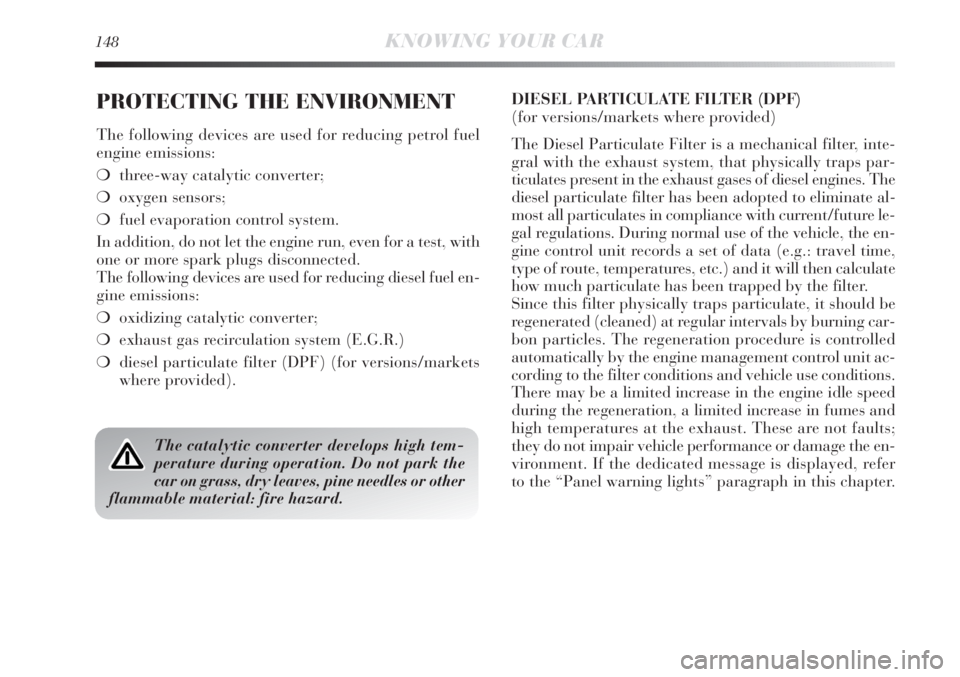
148KNOWING YOUR CAR
PROTECTING THE ENVIRONMENT
The following devices are used for reducing petrol fuel
engine emissions:
❍three-way catalytic converter;
❍oxygen sensors;
❍fuel evaporation control system.
In addition, do not let the engine run, even for a test, with
one or more spark plugs disconnected.
The following devices are used for reducing diesel fuel en-
gine emissions:
❍oxidizing catalytic converter;
❍exhaust gas recirculation system (E.G.R.)
❍diesel particulate filter (DPF) (for versions/markets
where provided).DIESEL PARTICULATE FILTER (DPF)
(for versions/markets where provided)
The Diesel Particulate Filter is a mechanical filter, inte-
gral with the exhaust system, that physically traps par-
ticulates present in the exhaust gases of diesel engines. The
diesel particulate filter has been adopted to eliminate al-
most all particulates in compliance with current/future le-
gal regulations. During normal use of the vehicle, the en-
gine control unit records a set of data (e.g.: travel time,
type of route, temperatures, etc.) and it will then calculate
how much particulate has been trapped by the filter.
Since this filter physically traps particulate, it should be
regenerated (cleaned) at regular intervals by burning car-
bon particles. The regeneration procedure is controlled
automatically by the engine management control unit ac-
cording to the filter conditions and vehicle use conditions.
There may be a limited increase in the engine idle speed
during the regeneration, a limited increase in fumes and
high temperatures at the exhaust. These are not faults;
they do not impair vehicle performance or damage the en-
vironment. If the dedicated message is displayed, refer
to the “Panel warning lights” paragraph in this chapter.
The catalytic converter develops high tem-
perature during operation. Do not park the
car on grass, dry leaves, pine needles or other
flammable material: fire hazard.
Page 150 of 290
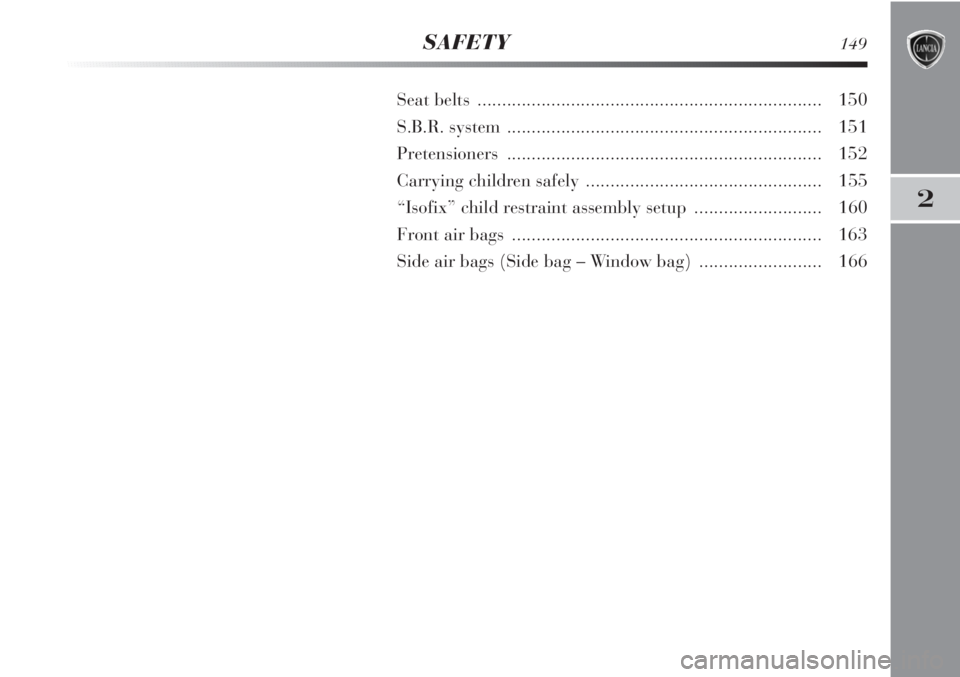
SAFETY149
2
Seat belts ...................................................................... 150
S.B.R. system ................................................................ 151
Pretensioners ................................................................ 152
Carrying children safely ................................................ 155
“Isofix” child restraint assembly setup .......................... 160
Front air bags ............................................................... 163
Side air bags (Side bag – Window bag) ......................... 166